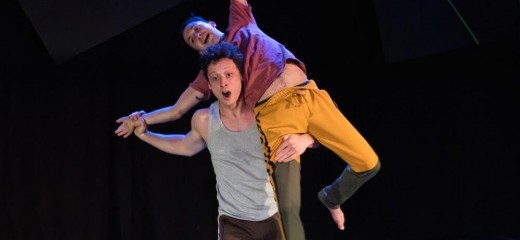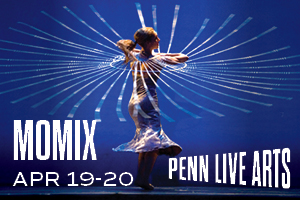
Almanac Dances Toward a Classical Ideal of Equality
by Mira Treatman
The latinate title of Almanac’s Communitas creates high expectations for its audience. Using the scholarly language implies authority on the subject or perhaps scientific empiricism. According to a program note, communitas is “an unstructured society in which individuals are equals.” A direct Latin translation is simply “community.” Despite the risk in christening the show this way, Almanac lands the grand majority of their experiments in pursuit of the community ideal.
Ben Grinberg, Almanac’s founding Artistic Director, graduated magna cum laude with a degree in classics from the University of Pennsylvania. In the years since Almanac’s premiere of Communitas, the company’s works continue to carry influences from Grinberg’s undergraduate studies—the mythic storytelling of Exile 2588 (2016), and the Odyssean sea journey in Leaps of Faith and Other Mistakes (2015/17). This influence provides the theater for the dance-circus-theater, and is a major force concerning the company’s style. The classical sensibility frames the dances as large, epic stories even in modest spaces.
Almanac has also just crossed a major threshold. Communitas, the revival of the dance theatre circus’s seminal work, marks the first half decade since the organization’s formal founding. Cementing itself as a company with historic repertory, the artists perform as a cohesive group with a distinct style, though the ensemble has shifted over the years. In this iteration, Grinberg and founding company member Adam Kerbel reprise their roles, and Almanac stalwarts Nicole Burgio and Lauren Johns join as replacements for original cast members Nick Gillette and Lauren Harries.
Johns and Burgio kick off the performance in the first of many duets. In physicality and style they resemble one another like sisters. Their individual spunk and competitive performance quality harkens back to the sweet verve of US Gymnastics darling Mary Lou Retton, although they are completely of the now. They tumble, leap, and pummel their bodies into breathtaking aerials with a fierce command of their instruments.
Kerbel and Grinberg offer a slapstick antidote. Their vaudevillian buffoonery has bits of Hopak-influenced jigs. They pants each other back and forth, yet a moment later they pivot into gravity-bending virtuosity where Kerbel is catapulted toward the heavens by Grinberg’s stable, sturdy base.
Composer Jordan McCree of Ill Doots provides live musical accompaniment, taking over from original composer Rob Emanuele. McCree’s propulsive bass and thick drumming hype the dancers into overdrive. Kerbel and Grinberg are clearly meant to be dance partners; where one ends, the other begins. Their years of collaboration have elevated the two to something transcendent.
A highlight of the work occurs in the duet for Grinberg and Burgio. They are tied to one another with an industrial rope pulled taut by their distance. Grinberg descends into a handstand while Burgio effortlessly steadies him by pulling back on the rope—a full-stage counter balance. Grinberg maintains the handstand as he inches his way toward Burgio by tightrope walking upside down, toe by toe, his back arching into an acute sickle. Burgio pulls back onto the rope until she cannot any longer, and the two end up in each other’s arms.
Communitas is most affecting when the performers strip down the clowning to a vulnerable underbelly. The audience is rapt during the riveting moments of connection and electrifying feats of the human body. At various moments, the flyers stand on a base’s shoulders with their eyes closed. They walk up the length of a dancer’s taut ankles and calves. They form counterbalances using every possible hand and foot connection. They plant a kiss on a castmate’s lips.
These direct acts of trust and risk are the closest moments to equality, although they do not necessarily reflect equity. There are distinct roles in the cast that appear to be based on relative body proportions. The folks with a lower center of gravity tend to serve as the base, the lithe folks are more likely to be the flyers. While it is true that every person flies off the ground as well as lifts others, these choreographies are both socially structured and not totally equal.
Almanac’s expertly crafted duets achieve a sense of divine equilibrium between the two players. When all four performers share the space, they do not quite reach the same level of trust and yoking together that the one-on-ones achieve. The stakes are incredibly high when the stage holds two people and no additional folks to catch or spot them.
The artists’ ultimate achievement of communitas is perhaps more meta. Reaching equality in an unstructured society, and certainly in a theater collective, is ever changing, never static. With half of the original cast and founding members of Almanac having moved on from the group, the show goes on. Perhaps Almanac’s offstage society is in fact the communitas in question.
Communitas, Almanac Dance Theatre Circus, Funicular Station, May 16 - 26.
By Mira Treatman
May 23, 2019





.png)


